An Analysis of Moral Obligations and Stakeholder Impact in Business
VerifiedAdded on 2022/08/24
|8
|2065
|18
Essay
AI Summary
This essay delves into the intricate relationship between moral obligations, businesses, and stakeholders, exploring the evolution of thought on corporate social responsibility. It begins by outlining three major viewpoints: Milton Friedman's narrow focus on shareholder interests, Evan and Freeman's broader stakeholder theory, and Goodpaster's perspective on fiduciary and moral duties. The essay examines the strengths and weaknesses of each viewpoint, analyzing the social contract between businesses and society, the implications of fiduciary arrangements, and the balance between profit and ethical practices. It discusses the role of stakeholder theory, the impact of strategic stakeholder synthesis, and the multi-fiduciary stakeholder synthesis approach. The essay emphasizes the importance of balancing stakeholder and stockholder interests, considering the influence of different stakeholder groups, and ultimately suggests a middle ground between fiduciary duties and moral obligations to ensure business sustainability while fulfilling ethical responsibilities. The essay references key thinkers and theories, offering a comprehensive analysis of ethical decision-making in a business context.
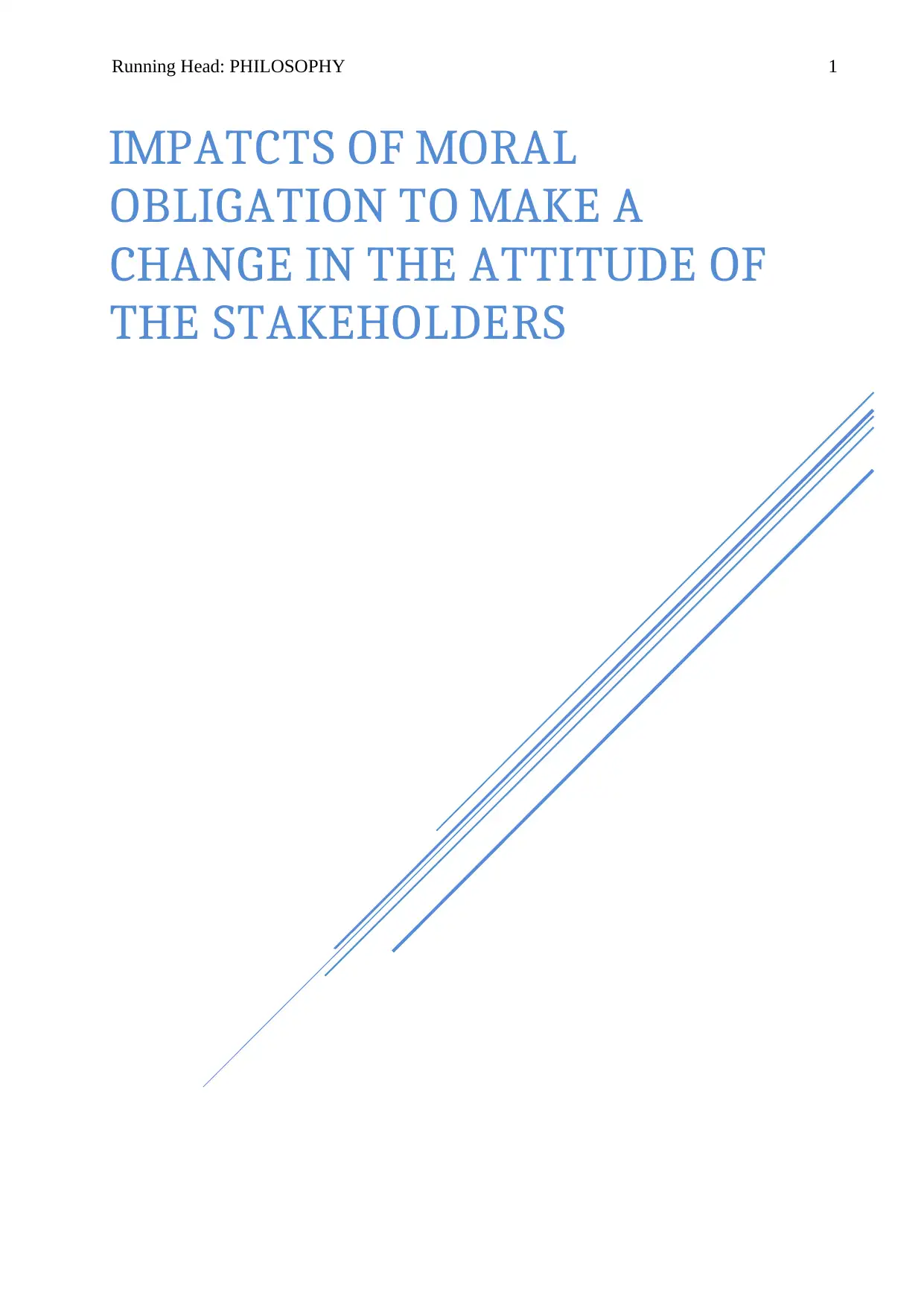
Running Head: PHILOSOPHY 1
IMPATCTS OF MORAL
OBLIGATION TO MAKE A
CHANGE IN THE ATTITUDE OF
THE STAKEHOLDERS
IMPATCTS OF MORAL
OBLIGATION TO MAKE A
CHANGE IN THE ATTITUDE OF
THE STAKEHOLDERS
Paraphrase This Document
Need a fresh take? Get an instant paraphrase of this document with our AI Paraphraser
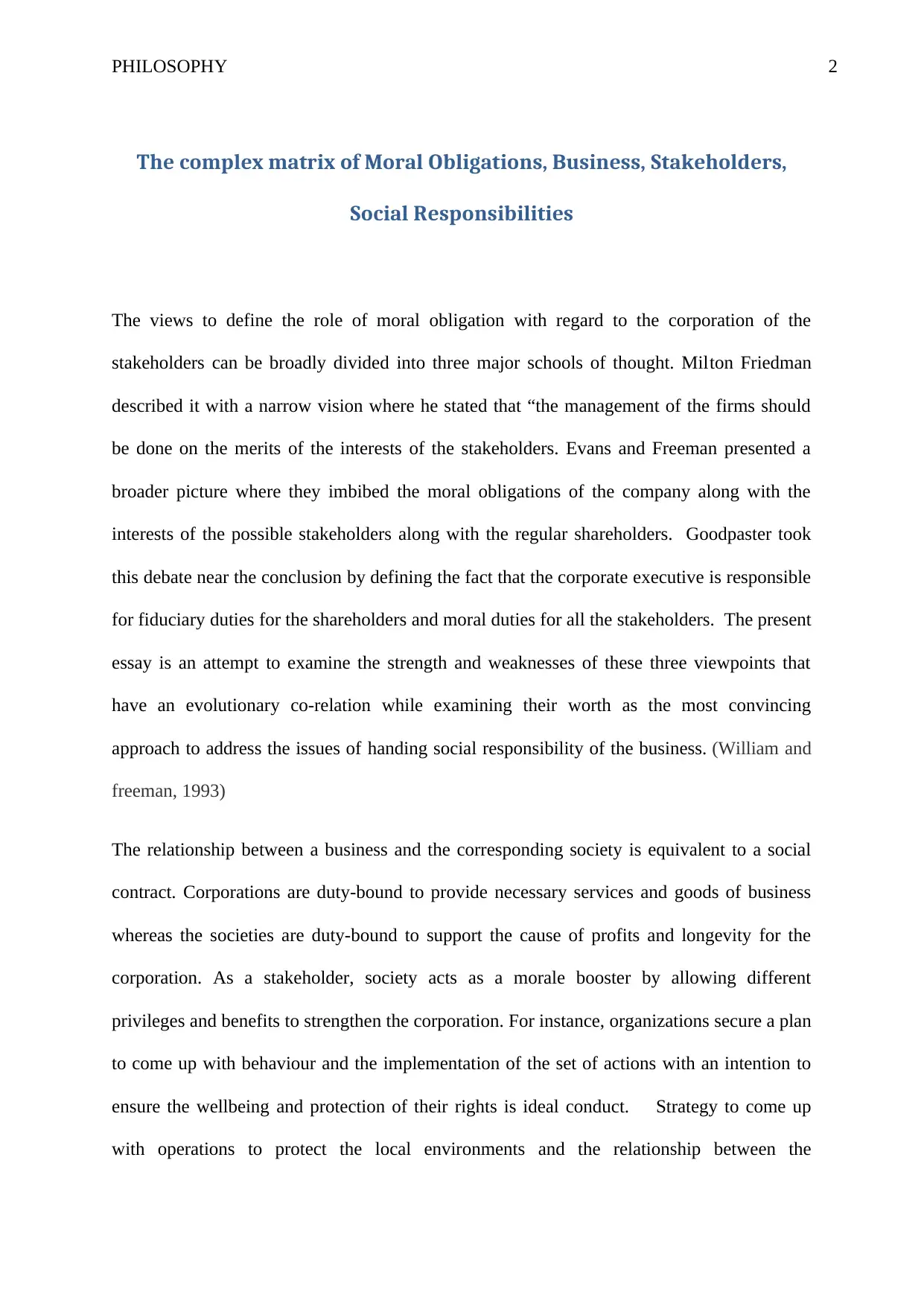
PHILOSOPHY 2
The complex matrix of Moral Obligations, Business, Stakeholders,
Social Responsibilities
The views to define the role of moral obligation with regard to the corporation of the
stakeholders can be broadly divided into three major schools of thought. Milton Friedman
described it with a narrow vision where he stated that “the management of the firms should
be done on the merits of the interests of the stakeholders. Evans and Freeman presented a
broader picture where they imbibed the moral obligations of the company along with the
interests of the possible stakeholders along with the regular shareholders. Goodpaster took
this debate near the conclusion by defining the fact that the corporate executive is responsible
for fiduciary duties for the shareholders and moral duties for all the stakeholders. The present
essay is an attempt to examine the strength and weaknesses of these three viewpoints that
have an evolutionary co-relation while examining their worth as the most convincing
approach to address the issues of handing social responsibility of the business. (William and
freeman, 1993)
The relationship between a business and the corresponding society is equivalent to a social
contract. Corporations are duty-bound to provide necessary services and goods of business
whereas the societies are duty-bound to support the cause of profits and longevity for the
corporation. As a stakeholder, society acts as a morale booster by allowing different
privileges and benefits to strengthen the corporation. For instance, organizations secure a plan
to come up with behaviour and the implementation of the set of actions with an intention to
ensure the wellbeing and protection of their rights is ideal conduct. Strategy to come up
with operations to protect the local environments and the relationship between the
The complex matrix of Moral Obligations, Business, Stakeholders,
Social Responsibilities
The views to define the role of moral obligation with regard to the corporation of the
stakeholders can be broadly divided into three major schools of thought. Milton Friedman
described it with a narrow vision where he stated that “the management of the firms should
be done on the merits of the interests of the stakeholders. Evans and Freeman presented a
broader picture where they imbibed the moral obligations of the company along with the
interests of the possible stakeholders along with the regular shareholders. Goodpaster took
this debate near the conclusion by defining the fact that the corporate executive is responsible
for fiduciary duties for the shareholders and moral duties for all the stakeholders. The present
essay is an attempt to examine the strength and weaknesses of these three viewpoints that
have an evolutionary co-relation while examining their worth as the most convincing
approach to address the issues of handing social responsibility of the business. (William and
freeman, 1993)
The relationship between a business and the corresponding society is equivalent to a social
contract. Corporations are duty-bound to provide necessary services and goods of business
whereas the societies are duty-bound to support the cause of profits and longevity for the
corporation. As a stakeholder, society acts as a morale booster by allowing different
privileges and benefits to strengthen the corporation. For instance, organizations secure a plan
to come up with behaviour and the implementation of the set of actions with an intention to
ensure the wellbeing and protection of their rights is ideal conduct. Strategy to come up
with operations to protect the local environments and the relationship between the
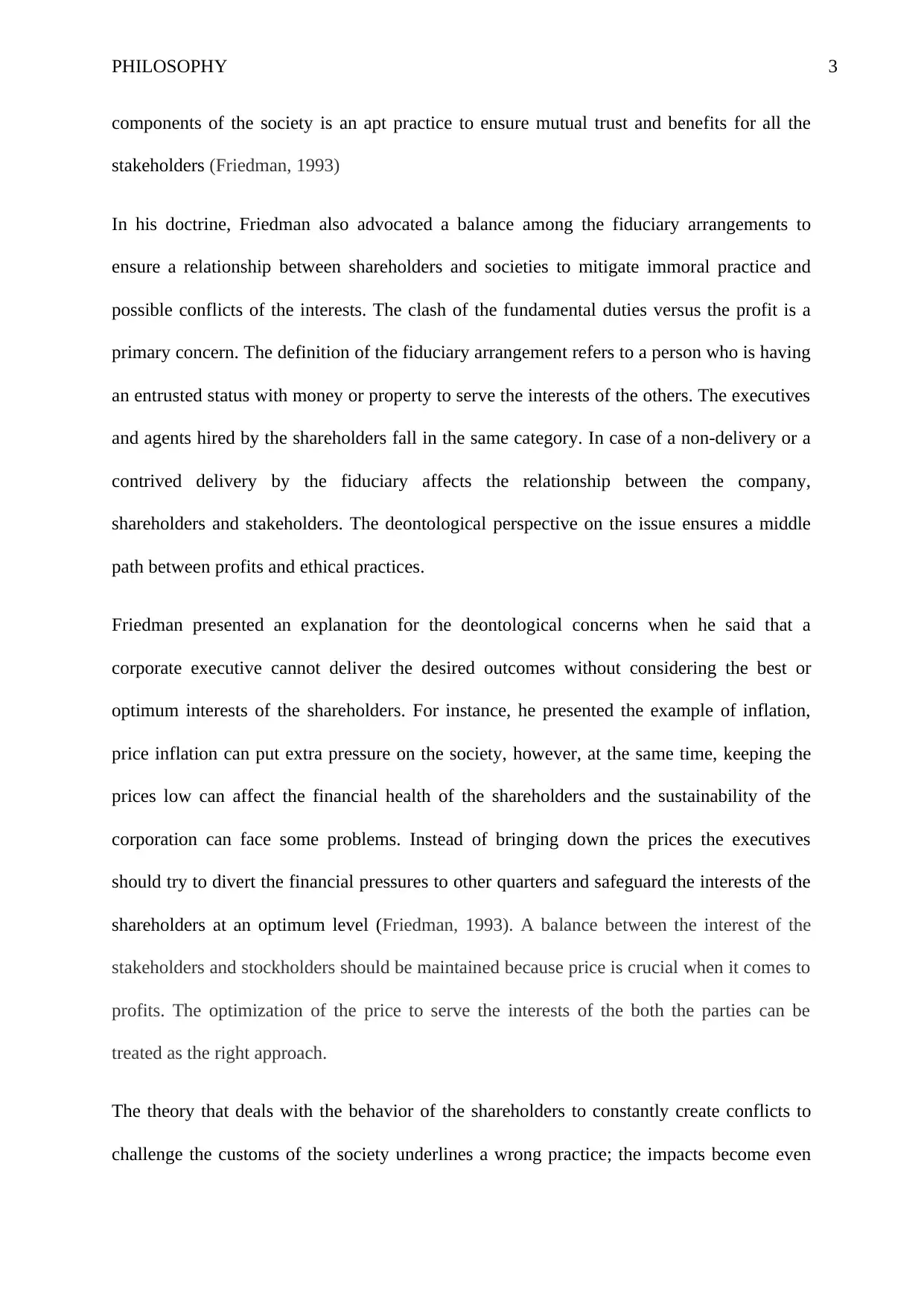
PHILOSOPHY 3
components of the society is an apt practice to ensure mutual trust and benefits for all the
stakeholders (Friedman, 1993)
In his doctrine, Friedman also advocated a balance among the fiduciary arrangements to
ensure a relationship between shareholders and societies to mitigate immoral practice and
possible conflicts of the interests. The clash of the fundamental duties versus the profit is a
primary concern. The definition of the fiduciary arrangement refers to a person who is having
an entrusted status with money or property to serve the interests of the others. The executives
and agents hired by the shareholders fall in the same category. In case of a non-delivery or a
contrived delivery by the fiduciary affects the relationship between the company,
shareholders and stakeholders. The deontological perspective on the issue ensures a middle
path between profits and ethical practices.
Friedman presented an explanation for the deontological concerns when he said that a
corporate executive cannot deliver the desired outcomes without considering the best or
optimum interests of the shareholders. For instance, he presented the example of inflation,
price inflation can put extra pressure on the society, however, at the same time, keeping the
prices low can affect the financial health of the shareholders and the sustainability of the
corporation can face some problems. Instead of bringing down the prices the executives
should try to divert the financial pressures to other quarters and safeguard the interests of the
shareholders at an optimum level (Friedman, 1993). A balance between the interest of the
stakeholders and stockholders should be maintained because price is crucial when it comes to
profits. The optimization of the price to serve the interests of the both the parties can be
treated as the right approach.
The theory that deals with the behavior of the shareholders to constantly create conflicts to
challenge the customs of the society underlines a wrong practice; the impacts become even
components of the society is an apt practice to ensure mutual trust and benefits for all the
stakeholders (Friedman, 1993)
In his doctrine, Friedman also advocated a balance among the fiduciary arrangements to
ensure a relationship between shareholders and societies to mitigate immoral practice and
possible conflicts of the interests. The clash of the fundamental duties versus the profit is a
primary concern. The definition of the fiduciary arrangement refers to a person who is having
an entrusted status with money or property to serve the interests of the others. The executives
and agents hired by the shareholders fall in the same category. In case of a non-delivery or a
contrived delivery by the fiduciary affects the relationship between the company,
shareholders and stakeholders. The deontological perspective on the issue ensures a middle
path between profits and ethical practices.
Friedman presented an explanation for the deontological concerns when he said that a
corporate executive cannot deliver the desired outcomes without considering the best or
optimum interests of the shareholders. For instance, he presented the example of inflation,
price inflation can put extra pressure on the society, however, at the same time, keeping the
prices low can affect the financial health of the shareholders and the sustainability of the
corporation can face some problems. Instead of bringing down the prices the executives
should try to divert the financial pressures to other quarters and safeguard the interests of the
shareholders at an optimum level (Friedman, 1993). A balance between the interest of the
stakeholders and stockholders should be maintained because price is crucial when it comes to
profits. The optimization of the price to serve the interests of the both the parties can be
treated as the right approach.
The theory that deals with the behavior of the shareholders to constantly create conflicts to
challenge the customs of the society underlines a wrong practice; the impacts become even
⊘ This is a preview!⊘
Do you want full access?
Subscribe today to unlock all pages.

Trusted by 1+ million students worldwide
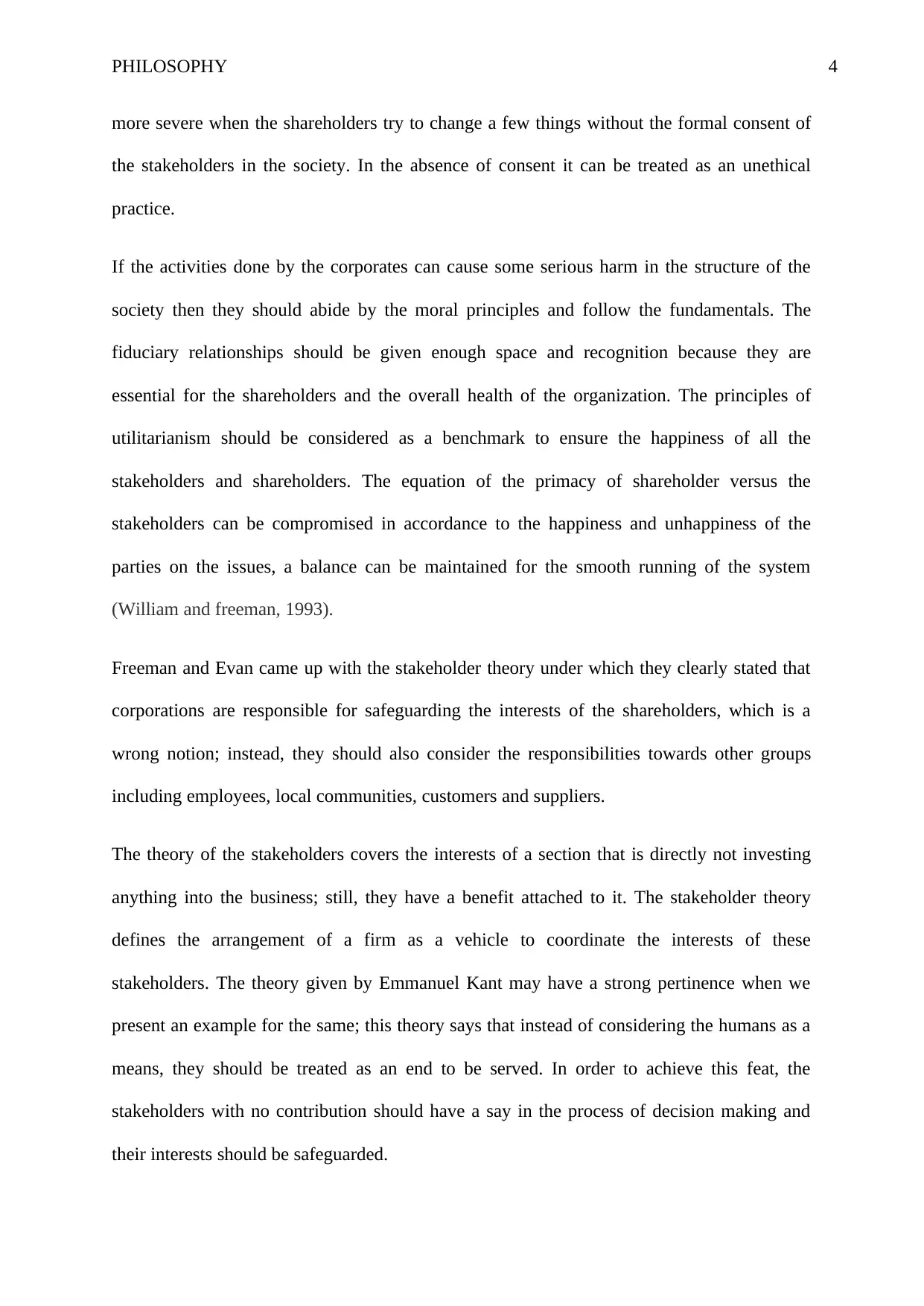
PHILOSOPHY 4
more severe when the shareholders try to change a few things without the formal consent of
the stakeholders in the society. In the absence of consent it can be treated as an unethical
practice.
If the activities done by the corporates can cause some serious harm in the structure of the
society then they should abide by the moral principles and follow the fundamentals. The
fiduciary relationships should be given enough space and recognition because they are
essential for the shareholders and the overall health of the organization. The principles of
utilitarianism should be considered as a benchmark to ensure the happiness of all the
stakeholders and shareholders. The equation of the primacy of shareholder versus the
stakeholders can be compromised in accordance to the happiness and unhappiness of the
parties on the issues, a balance can be maintained for the smooth running of the system
(William and freeman, 1993).
Freeman and Evan came up with the stakeholder theory under which they clearly stated that
corporations are responsible for safeguarding the interests of the shareholders, which is a
wrong notion; instead, they should also consider the responsibilities towards other groups
including employees, local communities, customers and suppliers.
The theory of the stakeholders covers the interests of a section that is directly not investing
anything into the business; still, they have a benefit attached to it. The stakeholder theory
defines the arrangement of a firm as a vehicle to coordinate the interests of these
stakeholders. The theory given by Emmanuel Kant may have a strong pertinence when we
present an example for the same; this theory says that instead of considering the humans as a
means, they should be treated as an end to be served. In order to achieve this feat, the
stakeholders with no contribution should have a say in the process of decision making and
their interests should be safeguarded.
more severe when the shareholders try to change a few things without the formal consent of
the stakeholders in the society. In the absence of consent it can be treated as an unethical
practice.
If the activities done by the corporates can cause some serious harm in the structure of the
society then they should abide by the moral principles and follow the fundamentals. The
fiduciary relationships should be given enough space and recognition because they are
essential for the shareholders and the overall health of the organization. The principles of
utilitarianism should be considered as a benchmark to ensure the happiness of all the
stakeholders and shareholders. The equation of the primacy of shareholder versus the
stakeholders can be compromised in accordance to the happiness and unhappiness of the
parties on the issues, a balance can be maintained for the smooth running of the system
(William and freeman, 1993).
Freeman and Evan came up with the stakeholder theory under which they clearly stated that
corporations are responsible for safeguarding the interests of the shareholders, which is a
wrong notion; instead, they should also consider the responsibilities towards other groups
including employees, local communities, customers and suppliers.
The theory of the stakeholders covers the interests of a section that is directly not investing
anything into the business; still, they have a benefit attached to it. The stakeholder theory
defines the arrangement of a firm as a vehicle to coordinate the interests of these
stakeholders. The theory given by Emmanuel Kant may have a strong pertinence when we
present an example for the same; this theory says that instead of considering the humans as a
means, they should be treated as an end to be served. In order to achieve this feat, the
stakeholders with no contribution should have a say in the process of decision making and
their interests should be safeguarded.
Paraphrase This Document
Need a fresh take? Get an instant paraphrase of this document with our AI Paraphraser
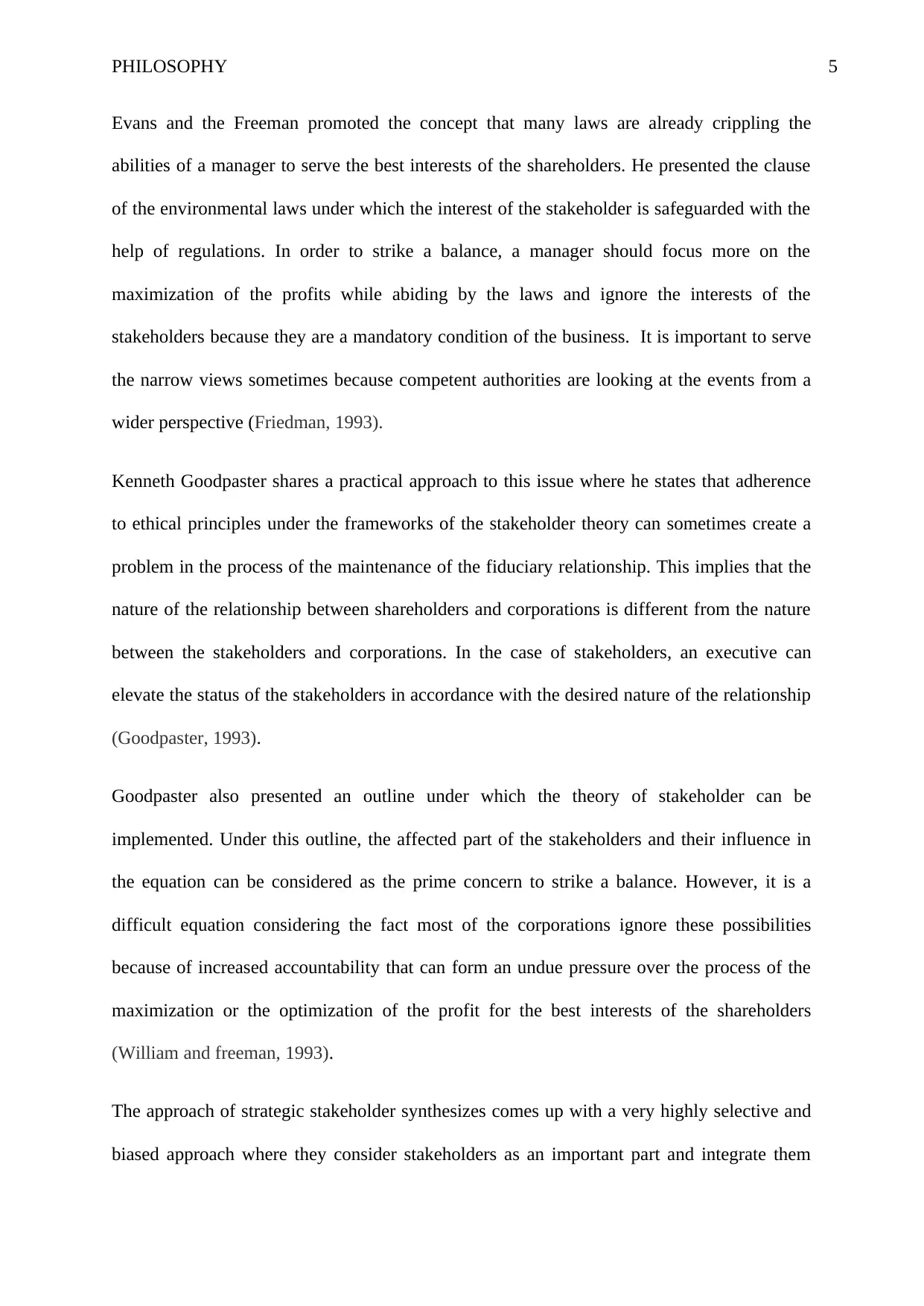
PHILOSOPHY 5
Evans and the Freeman promoted the concept that many laws are already crippling the
abilities of a manager to serve the best interests of the shareholders. He presented the clause
of the environmental laws under which the interest of the stakeholder is safeguarded with the
help of regulations. In order to strike a balance, a manager should focus more on the
maximization of the profits while abiding by the laws and ignore the interests of the
stakeholders because they are a mandatory condition of the business. It is important to serve
the narrow views sometimes because competent authorities are looking at the events from a
wider perspective (Friedman, 1993).
Kenneth Goodpaster shares a practical approach to this issue where he states that adherence
to ethical principles under the frameworks of the stakeholder theory can sometimes create a
problem in the process of the maintenance of the fiduciary relationship. This implies that the
nature of the relationship between shareholders and corporations is different from the nature
between the stakeholders and corporations. In the case of stakeholders, an executive can
elevate the status of the stakeholders in accordance with the desired nature of the relationship
(Goodpaster, 1993).
Goodpaster also presented an outline under which the theory of stakeholder can be
implemented. Under this outline, the affected part of the stakeholders and their influence in
the equation can be considered as the prime concern to strike a balance. However, it is a
difficult equation considering the fact most of the corporations ignore these possibilities
because of increased accountability that can form an undue pressure over the process of the
maximization or the optimization of the profit for the best interests of the shareholders
(William and freeman, 1993).
The approach of strategic stakeholder synthesizes comes up with a very highly selective and
biased approach where they consider stakeholders as an important part and integrate them
Evans and the Freeman promoted the concept that many laws are already crippling the
abilities of a manager to serve the best interests of the shareholders. He presented the clause
of the environmental laws under which the interest of the stakeholder is safeguarded with the
help of regulations. In order to strike a balance, a manager should focus more on the
maximization of the profits while abiding by the laws and ignore the interests of the
stakeholders because they are a mandatory condition of the business. It is important to serve
the narrow views sometimes because competent authorities are looking at the events from a
wider perspective (Friedman, 1993).
Kenneth Goodpaster shares a practical approach to this issue where he states that adherence
to ethical principles under the frameworks of the stakeholder theory can sometimes create a
problem in the process of the maintenance of the fiduciary relationship. This implies that the
nature of the relationship between shareholders and corporations is different from the nature
between the stakeholders and corporations. In the case of stakeholders, an executive can
elevate the status of the stakeholders in accordance with the desired nature of the relationship
(Goodpaster, 1993).
Goodpaster also presented an outline under which the theory of stakeholder can be
implemented. Under this outline, the affected part of the stakeholders and their influence in
the equation can be considered as the prime concern to strike a balance. However, it is a
difficult equation considering the fact most of the corporations ignore these possibilities
because of increased accountability that can form an undue pressure over the process of the
maximization or the optimization of the profit for the best interests of the shareholders
(William and freeman, 1993).
The approach of strategic stakeholder synthesizes comes up with a very highly selective and
biased approach where they consider stakeholders as an important part and integrate them
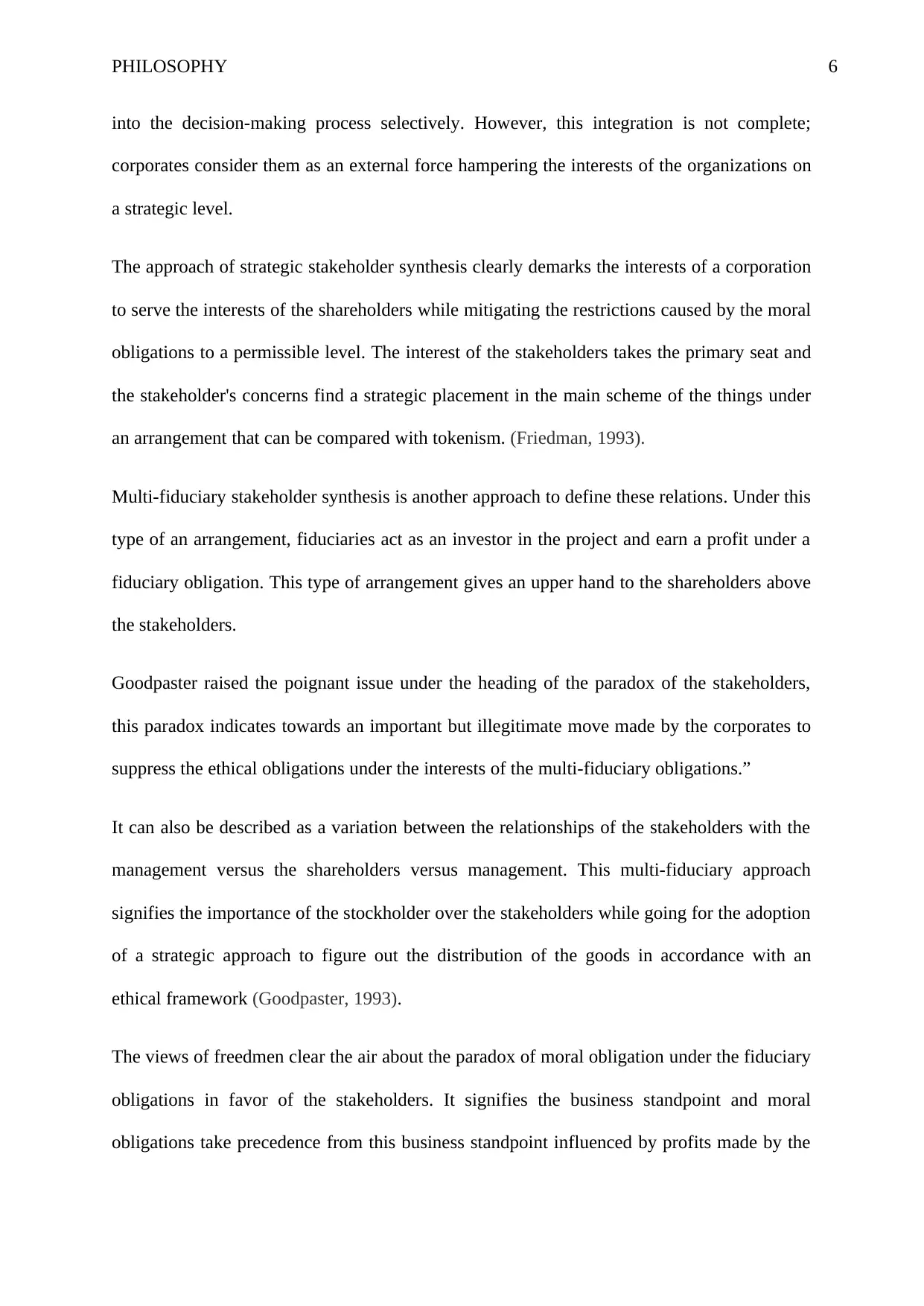
PHILOSOPHY 6
into the decision-making process selectively. However, this integration is not complete;
corporates consider them as an external force hampering the interests of the organizations on
a strategic level.
The approach of strategic stakeholder synthesis clearly demarks the interests of a corporation
to serve the interests of the shareholders while mitigating the restrictions caused by the moral
obligations to a permissible level. The interest of the stakeholders takes the primary seat and
the stakeholder's concerns find a strategic placement in the main scheme of the things under
an arrangement that can be compared with tokenism. (Friedman, 1993).
Multi-fiduciary stakeholder synthesis is another approach to define these relations. Under this
type of an arrangement, fiduciaries act as an investor in the project and earn a profit under a
fiduciary obligation. This type of arrangement gives an upper hand to the shareholders above
the stakeholders.
Goodpaster raised the poignant issue under the heading of the paradox of the stakeholders,
this paradox indicates towards an important but illegitimate move made by the corporates to
suppress the ethical obligations under the interests of the multi-fiduciary obligations.”
It can also be described as a variation between the relationships of the stakeholders with the
management versus the shareholders versus management. This multi-fiduciary approach
signifies the importance of the stockholder over the stakeholders while going for the adoption
of a strategic approach to figure out the distribution of the goods in accordance with an
ethical framework (Goodpaster, 1993).
The views of freedmen clear the air about the paradox of moral obligation under the fiduciary
obligations in favor of the stakeholders. It signifies the business standpoint and moral
obligations take precedence from this business standpoint influenced by profits made by the
into the decision-making process selectively. However, this integration is not complete;
corporates consider them as an external force hampering the interests of the organizations on
a strategic level.
The approach of strategic stakeholder synthesis clearly demarks the interests of a corporation
to serve the interests of the shareholders while mitigating the restrictions caused by the moral
obligations to a permissible level. The interest of the stakeholders takes the primary seat and
the stakeholder's concerns find a strategic placement in the main scheme of the things under
an arrangement that can be compared with tokenism. (Friedman, 1993).
Multi-fiduciary stakeholder synthesis is another approach to define these relations. Under this
type of an arrangement, fiduciaries act as an investor in the project and earn a profit under a
fiduciary obligation. This type of arrangement gives an upper hand to the shareholders above
the stakeholders.
Goodpaster raised the poignant issue under the heading of the paradox of the stakeholders,
this paradox indicates towards an important but illegitimate move made by the corporates to
suppress the ethical obligations under the interests of the multi-fiduciary obligations.”
It can also be described as a variation between the relationships of the stakeholders with the
management versus the shareholders versus management. This multi-fiduciary approach
signifies the importance of the stockholder over the stakeholders while going for the adoption
of a strategic approach to figure out the distribution of the goods in accordance with an
ethical framework (Goodpaster, 1993).
The views of freedmen clear the air about the paradox of moral obligation under the fiduciary
obligations in favor of the stakeholders. It signifies the business standpoint and moral
obligations take precedence from this business standpoint influenced by profits made by the
⊘ This is a preview!⊘
Do you want full access?
Subscribe today to unlock all pages.

Trusted by 1+ million students worldwide
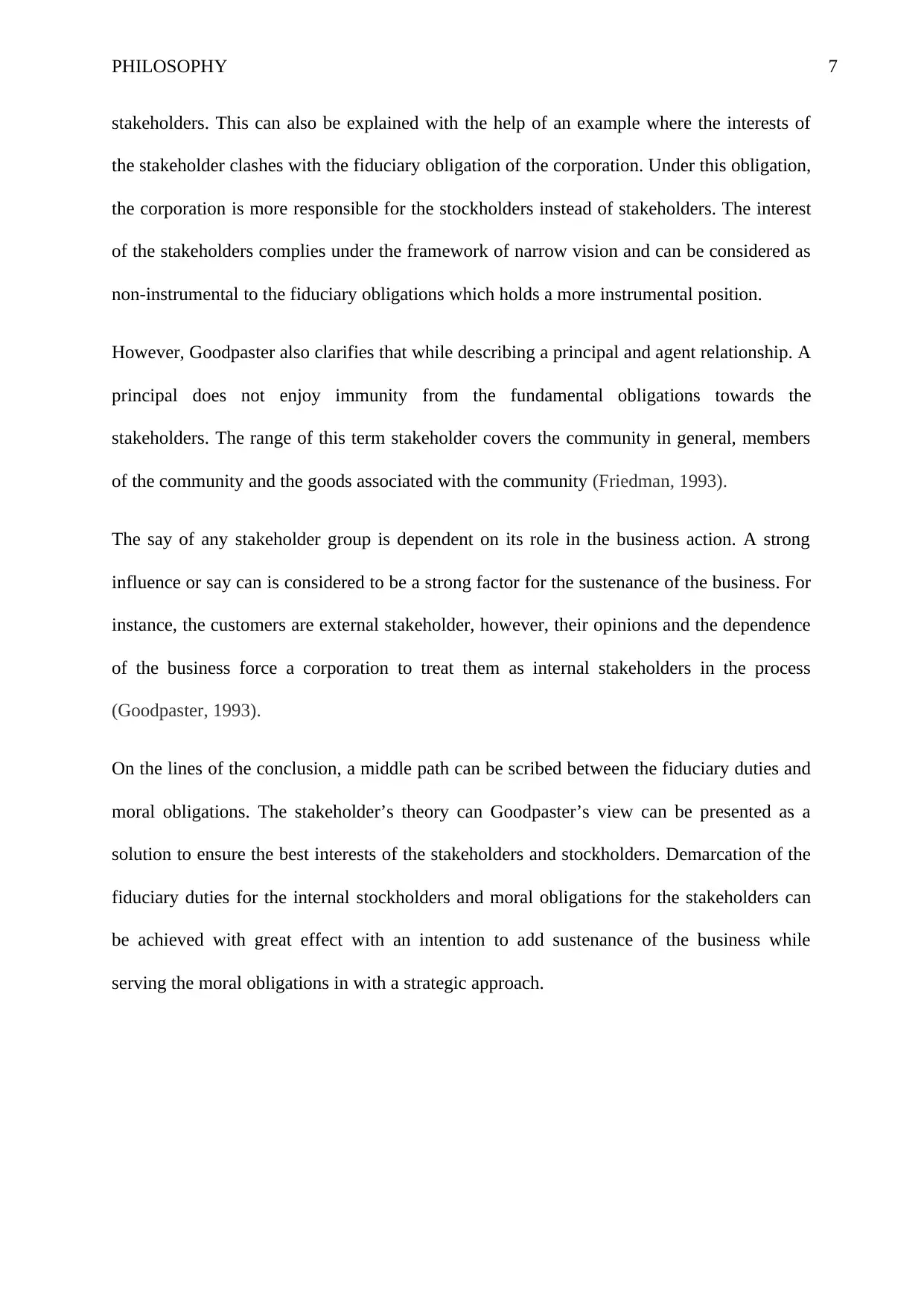
PHILOSOPHY 7
stakeholders. This can also be explained with the help of an example where the interests of
the stakeholder clashes with the fiduciary obligation of the corporation. Under this obligation,
the corporation is more responsible for the stockholders instead of stakeholders. The interest
of the stakeholders complies under the framework of narrow vision and can be considered as
non-instrumental to the fiduciary obligations which holds a more instrumental position.
However, Goodpaster also clarifies that while describing a principal and agent relationship. A
principal does not enjoy immunity from the fundamental obligations towards the
stakeholders. The range of this term stakeholder covers the community in general, members
of the community and the goods associated with the community (Friedman, 1993).
The say of any stakeholder group is dependent on its role in the business action. A strong
influence or say can is considered to be a strong factor for the sustenance of the business. For
instance, the customers are external stakeholder, however, their opinions and the dependence
of the business force a corporation to treat them as internal stakeholders in the process
(Goodpaster, 1993).
On the lines of the conclusion, a middle path can be scribed between the fiduciary duties and
moral obligations. The stakeholder’s theory can Goodpaster’s view can be presented as a
solution to ensure the best interests of the stakeholders and stockholders. Demarcation of the
fiduciary duties for the internal stockholders and moral obligations for the stakeholders can
be achieved with great effect with an intention to add sustenance of the business while
serving the moral obligations in with a strategic approach.
stakeholders. This can also be explained with the help of an example where the interests of
the stakeholder clashes with the fiduciary obligation of the corporation. Under this obligation,
the corporation is more responsible for the stockholders instead of stakeholders. The interest
of the stakeholders complies under the framework of narrow vision and can be considered as
non-instrumental to the fiduciary obligations which holds a more instrumental position.
However, Goodpaster also clarifies that while describing a principal and agent relationship. A
principal does not enjoy immunity from the fundamental obligations towards the
stakeholders. The range of this term stakeholder covers the community in general, members
of the community and the goods associated with the community (Friedman, 1993).
The say of any stakeholder group is dependent on its role in the business action. A strong
influence or say can is considered to be a strong factor for the sustenance of the business. For
instance, the customers are external stakeholder, however, their opinions and the dependence
of the business force a corporation to treat them as internal stakeholders in the process
(Goodpaster, 1993).
On the lines of the conclusion, a middle path can be scribed between the fiduciary duties and
moral obligations. The stakeholder’s theory can Goodpaster’s view can be presented as a
solution to ensure the best interests of the stakeholders and stockholders. Demarcation of the
fiduciary duties for the internal stockholders and moral obligations for the stakeholders can
be achieved with great effect with an intention to add sustenance of the business while
serving the moral obligations in with a strategic approach.
Paraphrase This Document
Need a fresh take? Get an instant paraphrase of this document with our AI Paraphraser
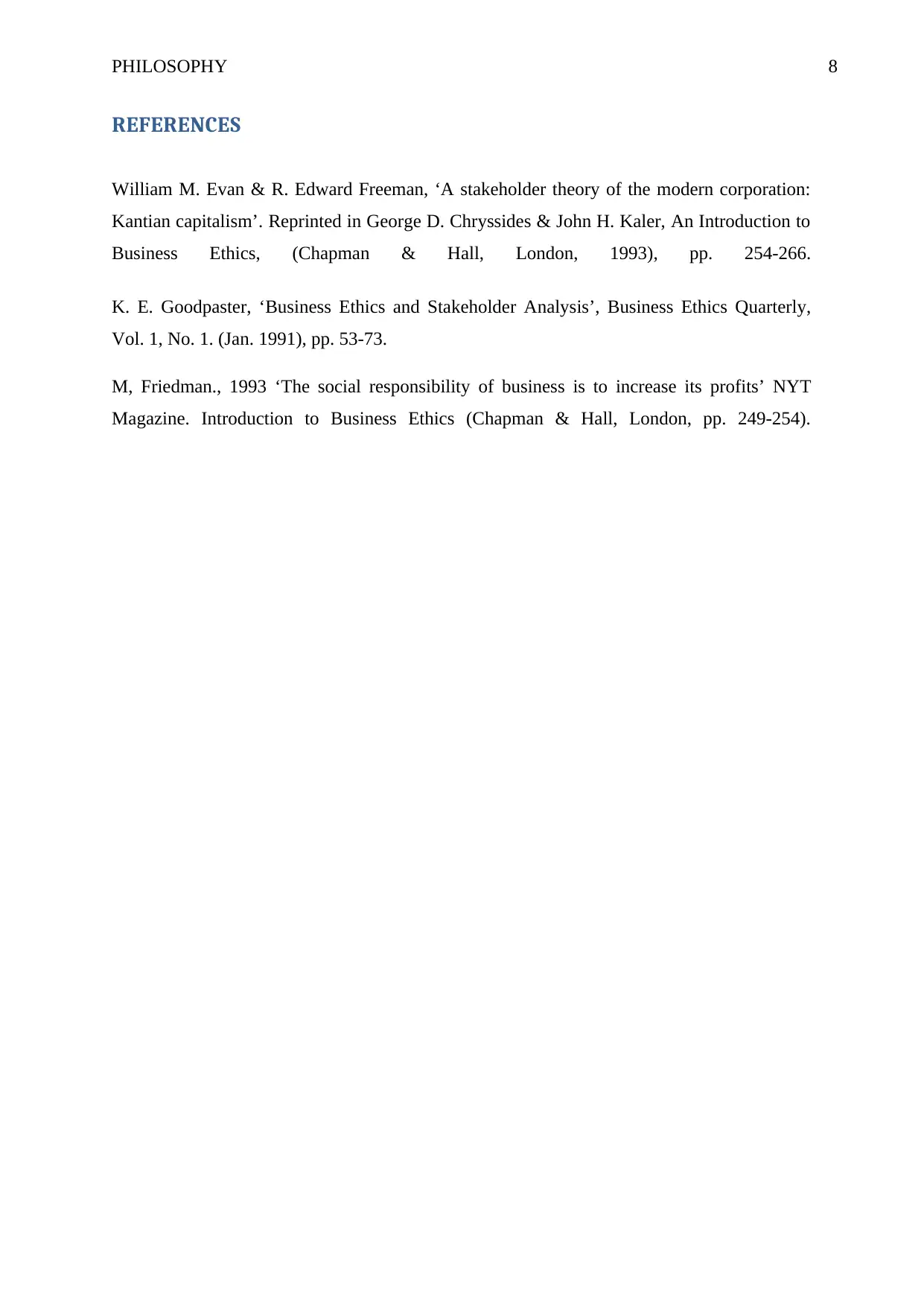
PHILOSOPHY 8
REFERENCES
William M. Evan & R. Edward Freeman, ‘A stakeholder theory of the modern corporation:
Kantian capitalism’. Reprinted in George D. Chryssides & John H. Kaler, An Introduction to
Business Ethics, (Chapman & Hall, London, 1993), pp. 254-266.
K. E. Goodpaster, ‘Business Ethics and Stakeholder Analysis’, Business Ethics Quarterly,
Vol. 1, No. 1. (Jan. 1991), pp. 53-73.
M, Friedman., 1993 ‘The social responsibility of business is to increase its profits’ NYT
Magazine. Introduction to Business Ethics (Chapman & Hall, London, pp. 249-254).
REFERENCES
William M. Evan & R. Edward Freeman, ‘A stakeholder theory of the modern corporation:
Kantian capitalism’. Reprinted in George D. Chryssides & John H. Kaler, An Introduction to
Business Ethics, (Chapman & Hall, London, 1993), pp. 254-266.
K. E. Goodpaster, ‘Business Ethics and Stakeholder Analysis’, Business Ethics Quarterly,
Vol. 1, No. 1. (Jan. 1991), pp. 53-73.
M, Friedman., 1993 ‘The social responsibility of business is to increase its profits’ NYT
Magazine. Introduction to Business Ethics (Chapman & Hall, London, pp. 249-254).
1 out of 8
Related Documents
Your All-in-One AI-Powered Toolkit for Academic Success.
+13062052269
info@desklib.com
Available 24*7 on WhatsApp / Email
![[object Object]](/_next/static/media/star-bottom.7253800d.svg)
Unlock your academic potential
Copyright © 2020–2025 A2Z Services. All Rights Reserved. Developed and managed by ZUCOL.



